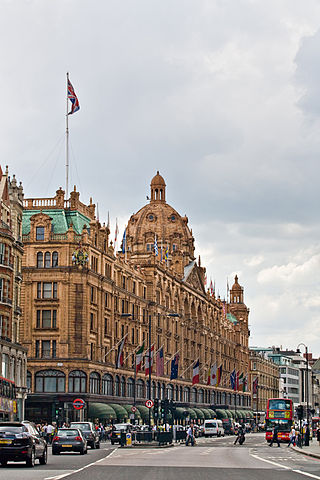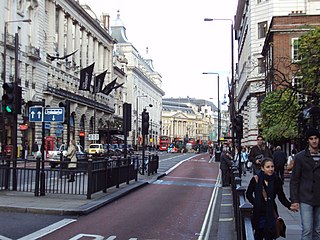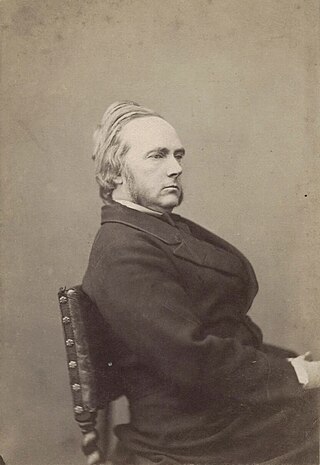
The West End of London is a district of Central London, London, England, west of the City of London and north of the River Thames, in which many of the city's major tourist attractions, shops, businesses, government buildings and entertainment venues, including West End theatres, are concentrated.

Knightsbridge is a residential and retail district in central London, south of Hyde Park. It is identified in the London Plan as one of two international retail centres in London, alongside the West End. Knightsbridge is also the name of the roadway which runs near the south side of Hyde Park from Hyde Park Corner.

Mayfair is an area in London, England and is located in the City of Westminster. It is in Central London and part of the West End. It is between Oxford Street, Regent Street, Piccadilly and Park Lane and one of the most expensive districts in the world.

Park Lane is a dual carriageway road in the City of Westminster in Central London. It is part of the London Inner Ring Road and runs from Hyde Park Corner in the south to Marble Arch in the north. It separates Hyde Park to the west from Mayfair to the east. The road has a number of historically important properties and hotels and has been one of the most sought after streets in London, despite being a major traffic thoroughfare.

Hyde Park is a 350-acre (140 ha), historic Grade I-listed urban park in Westminster, Greater London. A Royal Park, it is the largest of the parks and green spaces that form a chain from Kensington Palace through Kensington Gardens and Hyde Park, via Hyde Park Corner and Green Park, past Buckingham Palace to St James's Park. Hyde Park is divided by the Serpentine and the Long Water lakes.

Apsley House is the London townhouse of the Dukes of Wellington. It stands alone at Hyde Park Corner, on the south-east corner of Hyde Park, facing towards the large traffic roundabout in the centre of which stands the Wellington Arch. It is a Grade I listed building.

Piccadilly is a road in the City of Westminster, London, England, to the south of Mayfair, between Hyde Park Corner in the west and Piccadilly Circus in the east. It is part of the A4 road that connects central London to Hammersmith, Earl's Court, Heathrow Airport and the M4 motorway westward. St James's is to the south of the eastern section, while the western section is built up only on the northern side. Piccadilly is just under 1 mile (1.6 km) in length, and it is one of the widest and straightest streets in central London.

Hyde Park Corner is between Knightsbridge, Belgravia and Mayfair in London, England. It primarily refers to a major road junction at the southeastern corner of Hyde Park, that was originally planned by architect Decimus Burton. The junction includes a broad green-space roundabout in its centre, which is now the setting for Burton's triumphal Wellington Arch.

Sir William Hamilton, KB, PC, FRS, FRSE was a British diplomat, politician, antiquarian and vulcanologist who served as the Envoy Extraordinary to the Kingdom of Naples from 1764 to 1800. After sitting in the House of Commons of Great Britain from 1761 to 1764, he began working as a diplomat, succeeding Sir James Gray as the British ambassador to the Kingdom of Naples. While in Italy, Hamilton became involved in studying local volcanoes and collecting antiquities, becoming a fellow of the Royal Society and being given the Copley Medal. His second wife was Emma Hamilton, who was famed as the mistress of Horatio Nelson, 1st Viscount Nelson.

George John Douglas Campbell, 8th and 1st Duke of Argyll, was a Scottish polymath and Liberal statesman. He made a significant geological discovery in the 1850s when his tenant found fossilized leaves embedded among basalt lava on the Island of Mull. He also helped to popularize ornithology and was one of the first to give a detailed account of the principles of bird flight in the hopes of advancing artificial aerial navigation. His literary output was extensive writing on topics varying from science and theology to economy and politics. In addition to this, he served prominently in the administrations of Lord Aberdeen, Lord Palmerston, John Russell and William Gladstone.

Pall Mall is a street in the St James's area of the City of Westminster, Central London. It connects St James's Street to Trafalgar Square and is a section of the regional A4 road. The street's name is derived from pall-mall, a ball game played there during the 17th century, which in turn is derived from the Italian pallamaglio, literally "ball-mallet".

The Royal Aeronautical Society, also known as the RAeS, is a British multi-disciplinary professional institution dedicated to the global aerospace community. Founded in 1866, it is the oldest aeronautical society in the world. Members, Fellows, and Companions of the society can use the post-nominal letters MRAeS, FRAeS, or CRAeS, respectively.

Burlington House is a building on Piccadilly in Mayfair, London. It was originally a private English Baroque and then Neo-Palladian mansion owned by the Earls of Burlington. It was significantly expanded in the mid-19th century after being purchased by the British government. Today, the Royal Academy and five learned societies occupy much of the building.

Rotten Row is a broad track running 1,384 metres (4,541 ft) along the south side of Hyde Park in London. It leads from Hyde Park Corner to Serpentine Road. During the 18th and 19th centuries, Rotten Row was a fashionable place for upper-class Londoners to be seen horse riding. Today it is maintained as a place to ride horses in the centre of London, but it is little used as such.

The London Trocadero was an entertainment complex on Coventry Street, with a rear entrance in Shaftesbury Avenue, London. It was originally built in 1896 as a restaurant, which closed in 1965. In 1984, the complex reopened as an exhibition and entertainment space. It became known for the video-game oriented SegaWorld attractions which were added in 1996, and later downscaled and renamed to "Funland" before its closure in 2011. Part of the building was opened as a hotel in 2020.

Hamilton Place, City of Westminster is a side street off Piccadilly close to Hyde Park Corner, London.
Thomas Leverton was an English architect.
The Forum Club was a London Club for women. Located at 6 Grosvenor Place, it was founded in 1919 as The London Centre for Women's Institute Members, and lasted into the early 1950s. A number of suffragettes and early feminists were members, including Elizabeth Robins, Mary Sophia Allen and Sybil Thomas, Viscountess Rhondda.

The Old White Horse Cellar at No. 155 Piccadilly was one of the best-known coaching inns in England during the 18th and 19th centuries. The first mention of the White Horse Cellar is in 1720. It was originally located on the corner of Arlington Street, where the Ritz Hotel is now located. The first landlord, a man named Williams, named it in honor of the newly established House of Hanover, whose heraldic emblem featured a white horse. The White Horse rose to prominence under Abraham Hatchett who later moved it to the opposite side of the road on the corner of Albemarle Street, where it was known as "Hatchett’s Hotel and White Horse Cellar". The precise date of the move is not known, but was precipitated by the construction of the Bath Hotel, which was located on the corner of Piccadilly and Arlington as early as 1798. It was torn down in 1884 to make room for the Albemarle.

145 Piccadilly was a large terraced townhouse on Piccadilly in the London district of Mayfair that was built in the late 18th century. It was the residence of Hamar Bass in the late 19th century and home to the Duke and Duchess of York and two young daughters, Princesses Elizabeth and Margaret, from 1926 to 1936. It was badly damaged in an air raid in 1940 and demolished in 1959.



















